A Decision Support System That Considers Risk and Site Specificity in the Assessment of Irrigation Water Quality (IrrigWQ)
Abstract
:Featured Application
Abstract
1. Introduction
2. Materials and Methods
2.1. Overview
- Tier 1 resembles the current South African generic guidelines (Department of Water Affairs and Forestry, 1996), with some modifications, and is similar to guidelines developed for other countries. Tier 1 assessments make use of a number of conservative simplifying assumptions, like no rain, a sensitive crop, a low leaching fraction (10%), and a relatively high level of water application and, thus, constituent load, all factors that largely determine the water quality required for irrigation. Consequently, only the composition of irrigation water is required as input to generate FFU assessments, highlighting potential problems that can be expected under these specified conservative assumptions. Should a Tier 1 evaluation indicate potential problems, more rigorous, site-specific Tier 2 evaluations are indicated to determine whether these problems can be overcome when site-specific conditions are considered.
- Tier 2 considers site-specific conditions when assessing WQRs or FFU. IrrigWQ allows a user to conduct a more in-depth water quality assessment and guideline generation by making use of a relatively sophisticated crop growth–soil water balance and chemical equilibrium model that caters for selectable, default site-specific input parameters to simulate the response of soils, crops, and irrigation infrastructure to irrigation water of a specific composition under user-defined, site-specific conditions. This provides a significantly enhanced assessment of how crop selection, climatic conditions, irrigation management, and soil texture can be expected to determine the effect of specific water composition on soil quality, crop yield and quality, or irrigation infrastructure.
- The compilation of a concise literature review documenting the current understanding of how water quality constituents, soils, crops, climate, irrigation systems, irrigation management, and other factors interact to impact the resultant soil quality, crop yield and quality, and the performance of irrigation infrastructure. The review provided the theoretical basis or technical framework for the development of IrrigWQ [10].
- The development of a Technology Demonstrator that consisted of the preliminary software system that demonstrated the most important features of Tiers 1 and 2 for six water quality constituents representing different categories of constituents, namely salinity (electrical conductivity or EC) as a major inorganic constituent, Cr and Zn as trace elements, pesticides, microbial contamination, and those constituents affecting the corrosion and scaling of irrigation infrastructure.
- A demonstration of the Technology Demonstrator to potential user groups, who made several suggestions for improvement.
- The development of a fully functional draft DSS incorporating all the features and water quality constituents envisaged for the final IrrigWQ.
- The testing and evaluation of the draft DSS by individual water quality experts to evaluate its user friendliness and acceptability, as well as the confidence that can be placed in its ability to make reliable and realistic evaluations.
- The release of IrrigWQ for use and evaluation by the wider irrigation community.
- The continued introduction of enhancements to improve utility and user friendliness.
2.2. The Decision Support System (DSS)
- Assessing the FFU of water for irrigation;
- Setting WQR for a water source to be used for irrigation;
- Obtaining additional information.
2.3. The Development Platform
2.4. Calculating Procedures
2.5. Water Quality Constituents and Their Effect on Soil Quality, Crop Yield and Quality, and Irrigation Infrastructure
2.5.1. Effect of Water Quality Constituents on Soil Quality
- Soil profile salinity
- ii.
- Soil permeability
- iii.
- Oxidisable carbon loading.
- iv.
- Trace element accumulation
2.5.2. Effect of Water Quality Constituents on Crop Yield and Quality
- Root zone effects of irrigation water salinity, B, Cl and Na on crop yield
- ii.
- Scorching of leaves when wetted
- iii.
- Contribution to the NPK uptake of the crop
- iv.
- Risk of microbial contamination from consuming crops
- v.
- Qualitative crop damage by atrazine
2.5.3. Effect of Water Quality Constituents on Irrigation Infrastructure
- Corrosion or scaling of irrigation equipment
- ii.
- Clogging of drippers
2.6. Presentation of Risk Associated with Water Composition
2.7. Generating and Displaying IrrigWQ Output
- The cover output page presents information on the user’s description of the assessment that was conducted and the water analysis. For Tier 2 assessments, it also displays the site-specific characteristics on which the evaluation is based and a summary of the seasonal water balance components, as calculated during the simulation.
- The second output page presents an overview of the FFU assessment of the four suitability indicators that characterise soil quality.
- The third output page presents an overview of the FFU assessment of the five suitability indicators that characterise crop yield and quality. If a crop rotation was selected for the Tier 2 assessment, the overview of the five suitability indicators for the second crop is printed on a fourth page.
- The fourth page (or the fifth page in the case where a two-crop rotation was selected) presents an overview of the FFU assessment of the two suitability indicators that characterise the effect of water constituents on the performance of irrigation infrastructure.
- Successive FFU assessments are conducted for specified periods of between 10 and 45 years using a number of pre-defined, hard-coded, model waters, having increasing constituent concentrations.
- The 95th percentile highest or lowest (as the case may be) annual or seasonal value of the suitability indicator is identified for each of the model water concentrations.
- The threshold WQR concentrations corresponding to the criteria boundaries used for FFU categories are determined by interpolation from the 95th percentile highest or lowest annual or seasonal values of the suitability indicator.
2.8. Statistical Analysis
3. Results and Discussion
3.1. Validation of IrrigWQ Output
- Precipitation was artificially set to zero in the weather station database (the Douglas, South Africa, weather station was used. Latitude (S) -29.05. Longitude (E) 23.77);
- Irrigation management was adjusted to achieve leaching fractions of approximately 15% and 20%, which is in line with the leaching fraction range assumed by the FAO guidelines for their calculations;
- IrrigWQ was run for a period of 40 years using the irrigation water ECs, which were calculated by the FAO guidelines to produce relative yields of 75%, 90%, and 100% for five crops with widely varying salinity tolerance (namely, barley, wheat, soybeans, maize, and carrots).
3.2. Differences in Output and Use of Tiers 1 and 2 to Assess FFU and Determine WQRs
3.2.1. FFU Evaluations for Tiers 1 and 2
3.2.2. WQR Determinations for Tiers 1 and 2
3.3. Demonstration of Effect of Climate on Expected Crop Yield
4. Discussion
5. Conclusions
Author Contributions
Funding
Institutional Review Board Statement
Informed Consent Statement
Data Availability Statement
Conflicts of Interest
References
- United States Salinity Laboratory Staff. Diagnosis and Improvement of Saline and Alkali Soils; Agriculture Handbook No. 60; USDA: Washington, DC, USA, 1954. [Google Scholar]
- Ayers, R.S.; Westcot, D.W. Water Quality for Agriculture; Food and Agriculture Organization of the United Nations: Rome, Italy, 1985. [Google Scholar]
- Agricultural Salinity Assessment and Management; ASCE Manuals and Reports on Engineering Practice No. 71; Tanji, K.K. (Ed.) ASCE: New York, NY, USA, 1990. [Google Scholar]
- Zaman, M.; Shahid, S.A.; Heng, L. Irrigation water quality. In Guideline for Salinity Assessment, Mitigation and Adaptation Using Nuclear and Related Techniques; Springer: Cham, Switzerland, 2018; pp. 113–131. [Google Scholar]
- SALF2 Salinity Modeling Tool. Version 2.2.2a. 2022. Available online: https://www.publications.qld.gov.au/dataset/salinity-management-handbook/resource/4b2b58ae-1b6d-46f0-a64f-e5d6ff17d308?inner_span=True (accessed on 11 November 2023).
- Australian and New Zealand Environment and Conservation Council (ANZECC). Australian and New Zealand Guidelines for Fresh and Marine Water Quality; Australian Water Association: Artarmon, NSW, Australia, 2000. [Google Scholar]
- Canadian Council of Resource and Environment Ministers (CCREM). Canadian Water Quality Guidelines; Prepared by the Task Force on Water Quality Guidelines; The Council: Ottawa, Canada, 1987. [Google Scholar]
- Department of Water Affairs and Forestry RSA (DWAF). South African Water Quality Guidelines—4: Agricultural Use: Irrigation, 2nd ed.; DWAF: Pretoria, South Africa, 1996. [Google Scholar]
- Department of Water Affairs and Forestry RSA (DWAF). Development of SA Risk-Based Water Quality Guidelines: Phase 1: Needs Assessment and Philosophy; Coordinated by Heath, R.C., Ed.; DWAF: Pretoria, South Africa, 2008. [Google Scholar]
- du Plessis, M.; Annandale, J.; Benadé, N.; van der Laan, M.; Jooste, S.; du Preez, C.; Barnard, J.; Rodda, N.; Dabrowski, J.; Genthe, B.; et al. Risk Based, Site-Specific, Irrigation Water Quality Guidelines: Volume 2 Technical Support; WRC Report No TT 728/17 Water; Research Commission: Pretoria, South Africa, 2017. [Google Scholar]
- Lazarus: The Professional Free Pascal RAD IDE. Version 2.0.10. (Lazarus Team, 1993–2020). Available online: http://www.lazarus-ide.org (accessed on 6 September 2023).
- Firebird: Firebird Project (2000–2022). Available online: https://firebirdsql.org/en/firebird-4-0-1/ (accessed on 6 September 2023).
- Rhoades, J. Reclamation and management of salt affected soil after drainage. In Proceedings of the 1st Annual Western Provincial Conference Rationalization of Water and Soil Research and Management, Lightbridge, AL, Canada, 29 November–2 December 1982. [Google Scholar]
- Annandale, J.; Stirzaker, R.; Singels, A.; Van Der Laan, M.; Laker, M. Irrigation scheduling research: South African experiences and future prospects. Water SA 2011, 2011 37, 751–763. [Google Scholar] [CrossRef]
- Smith, M.; Allen, R.G.; Pereira, L.S. Revised FAO methodology for crop water requirements. In Proceedings of the International Conference on Evapotranspiration and Irrigation Scheduling, San Antonio, TX, USA, 3–6 November 1996; pp. 133–140. [Google Scholar]
- Annandale, J.; Jovanovic, N.; Benade, N.; Tanner, P. Modelling the long-term effect of irrigation with gypsiferous water on soil and water resources. Agric. Ecosyst. Environ. 1999, 76, 109–119. [Google Scholar] [CrossRef]
- Robbins, C.H. Solute transport and reactions in salt-affected soils. In Modelling Plant and Soil Systems; Agronomy Monograph No, 31; Hanks, R.J., Ritchie, J.T., Eds.; ASA-CSSA-SSSSA: Madison, WI, USA, 1991; pp. 365–395. [Google Scholar]
- Maas, E.V.; Hoffman, G.J. Crop salt tolerance—Current assessment. J. Irrig. Drain. Div. ASCE 1977, 103, 115–134. [Google Scholar] [CrossRef]
- Shainberg, I.; Letey, J. Response of soils to sodic and saline conditions. Hilgardia 1984, 52, 1–57. [Google Scholar] [CrossRef]
- US Environmental Protection Agency. US EPA Proposed Criteria for Water Quality; UP EPA: Washington, DC, USA, 1973; Volume 1, 93p. [Google Scholar]
- Maas, E.V. Crop Salt Tolerance. In Agricultural Salinity Assessment and Management; Tanji, K.K., Ed.; ASCE: New York, NY, USA, 1990; pp. 262–304. [Google Scholar]
- Teunis, P.F.M.; Moe, C.L.; Liu, P.; Miller, S.E.; Lindesmith, L.; Baric, R.S.; Le Pendu, J.; Calderon, R.L. Norwalk Virus: How Infectious is It? J. Med. Virol. 2008, 80, 1468–1476. [Google Scholar] [CrossRef] [PubMed]
- Nakayama, F.S.; Bucks, D.A. Water Quality in Drip/trickle Irrigation: A Review. Irrig. Sci. 1991, 12, 187–192. [Google Scholar] [CrossRef]
- Schulze, R.E.; Maharaj, M. 50 Years of Daily Hydro-Climatic Data per Quaternary Catchment in South Africa; CD with data; University of KwaZulu-Natal School of Bio-Resource Engineering and Environmental Hydrology: Pietermaritzburg, South Africa, 2006. [Google Scholar]
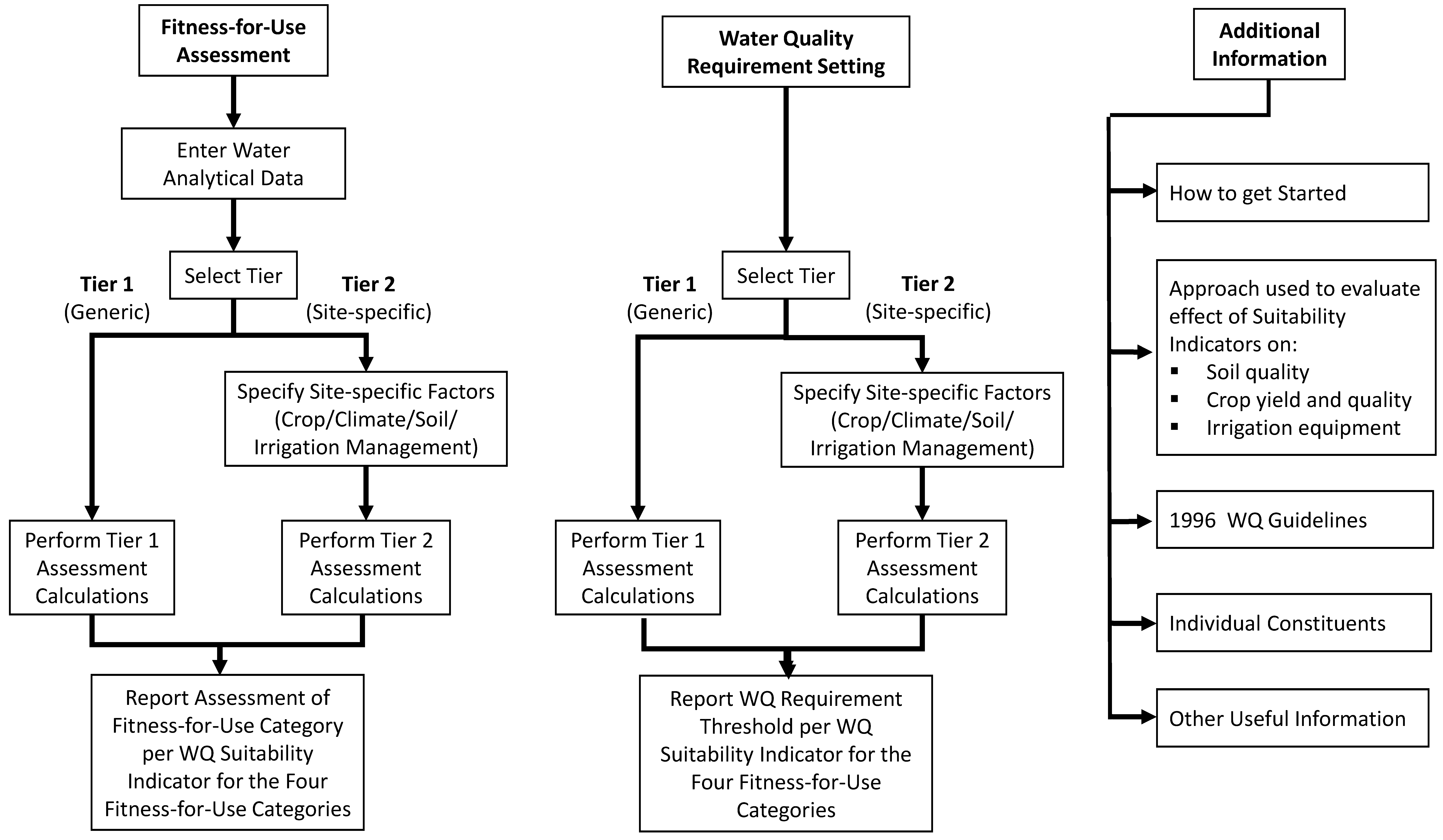
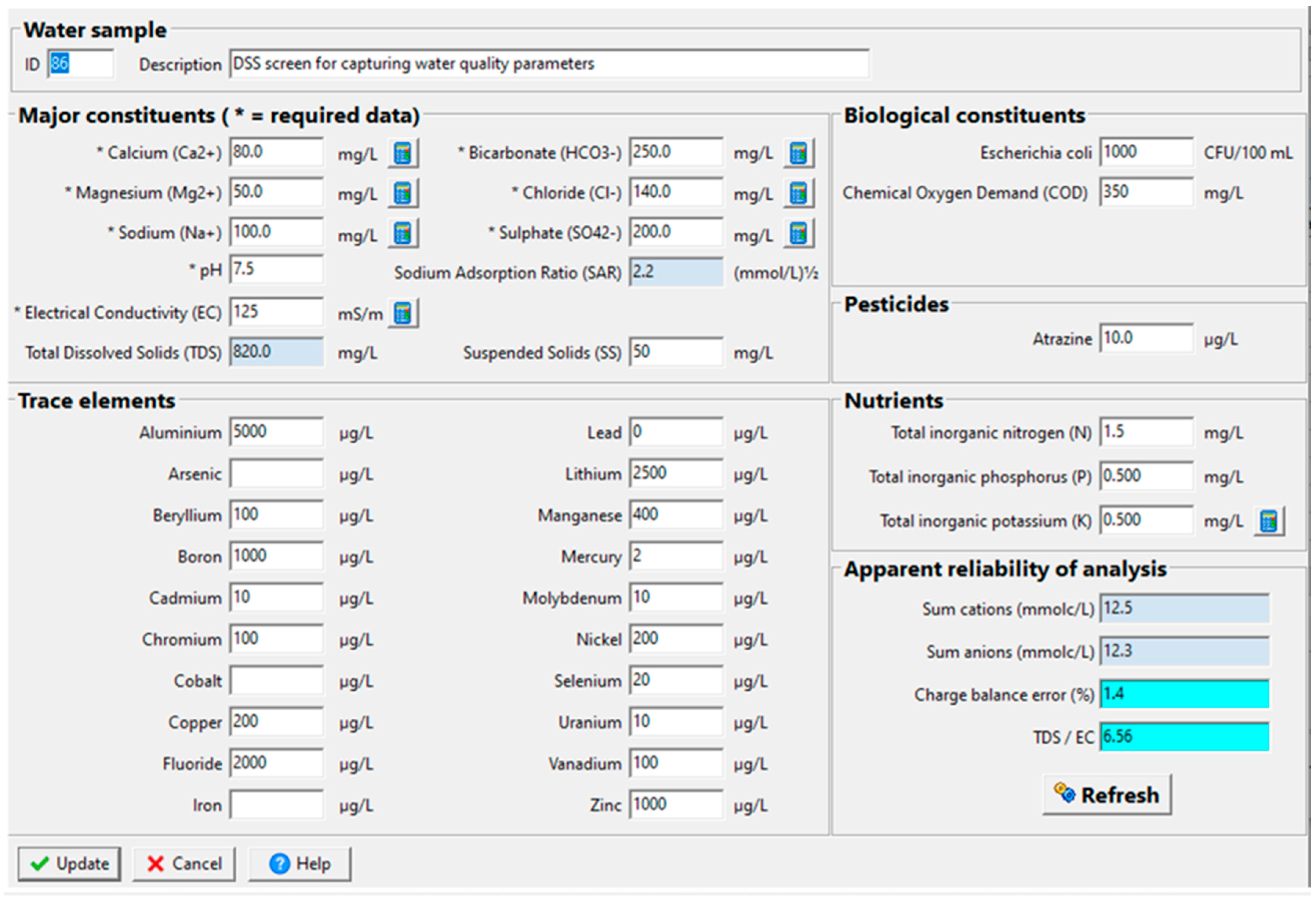
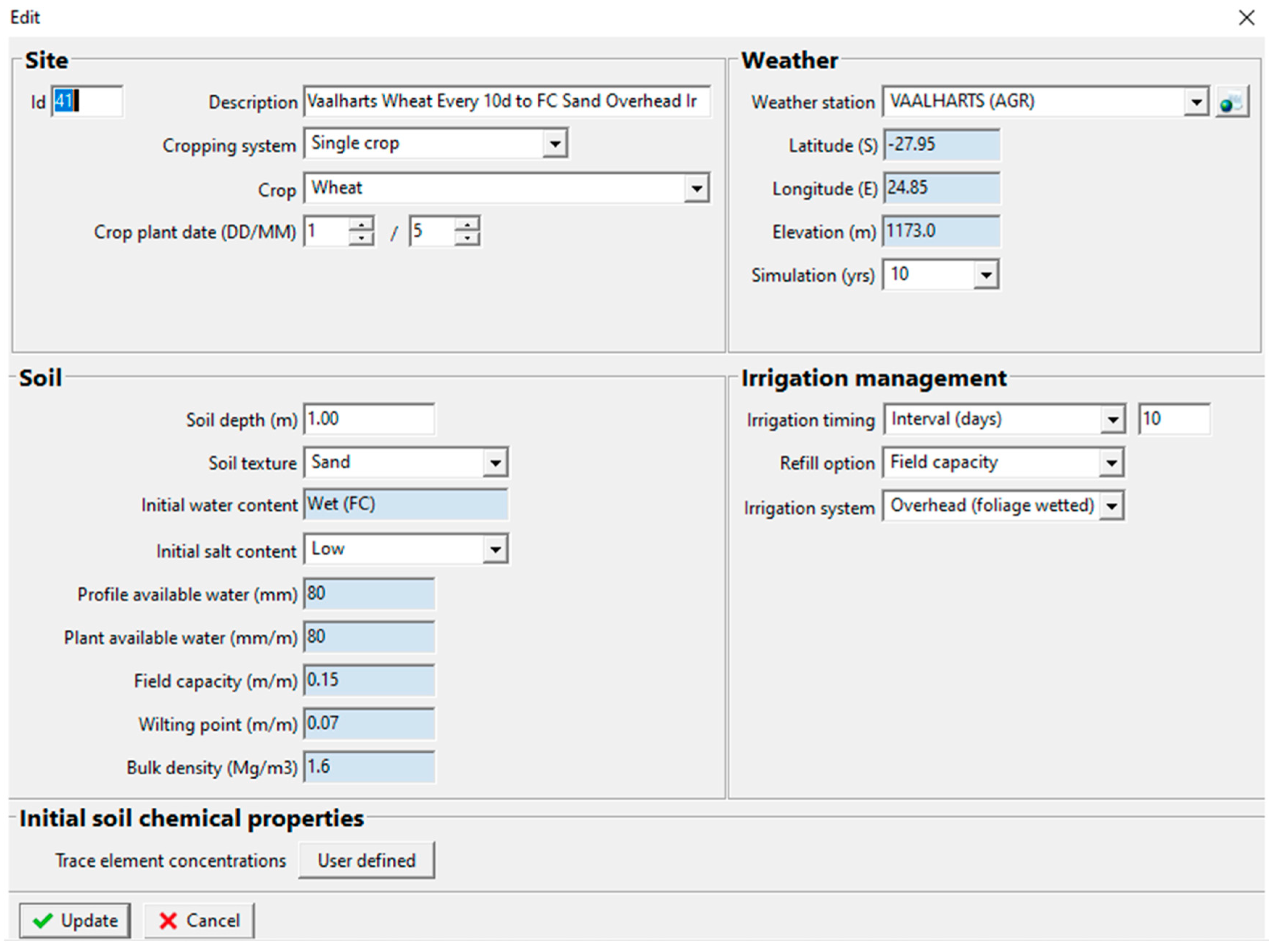
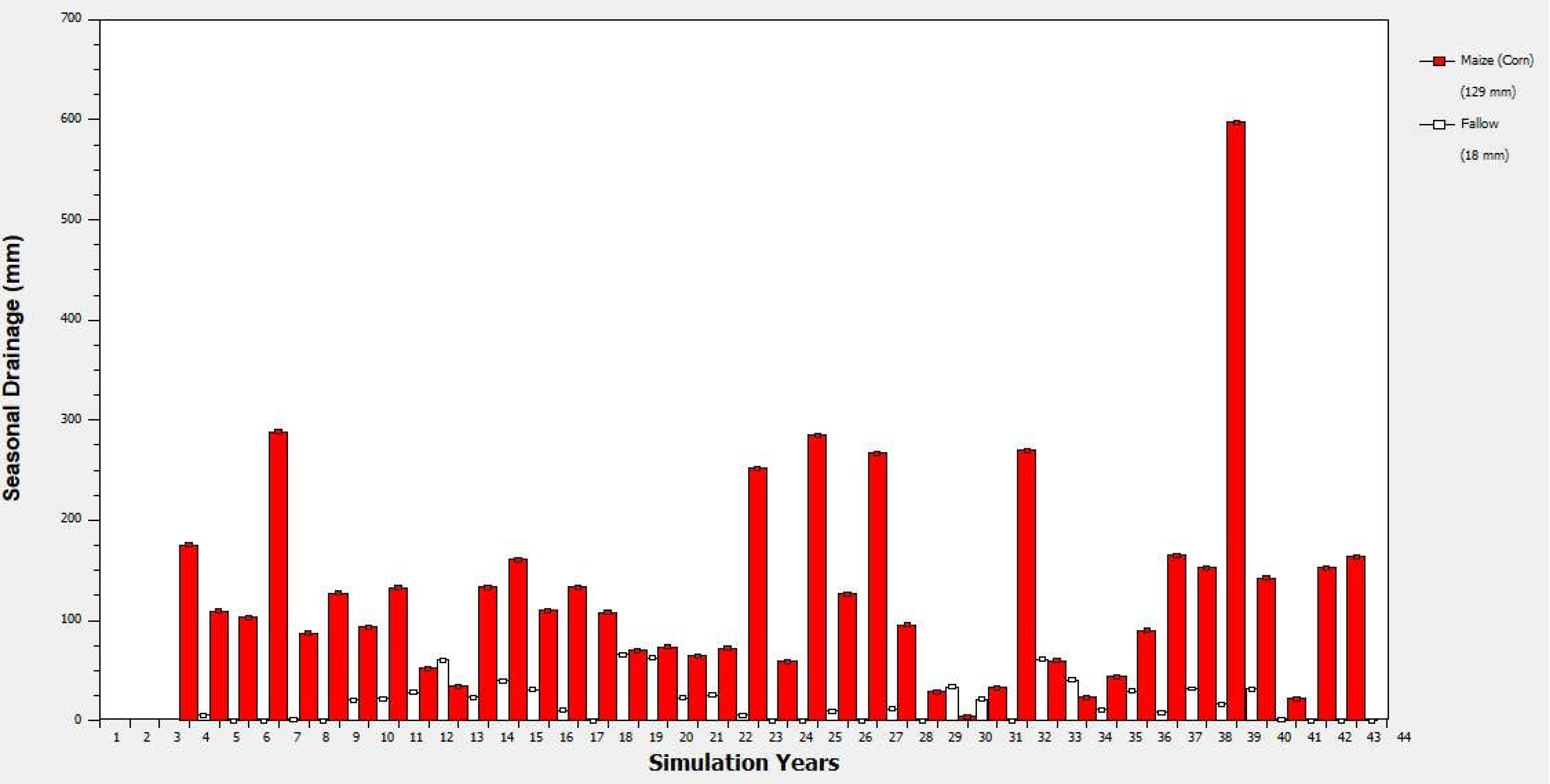
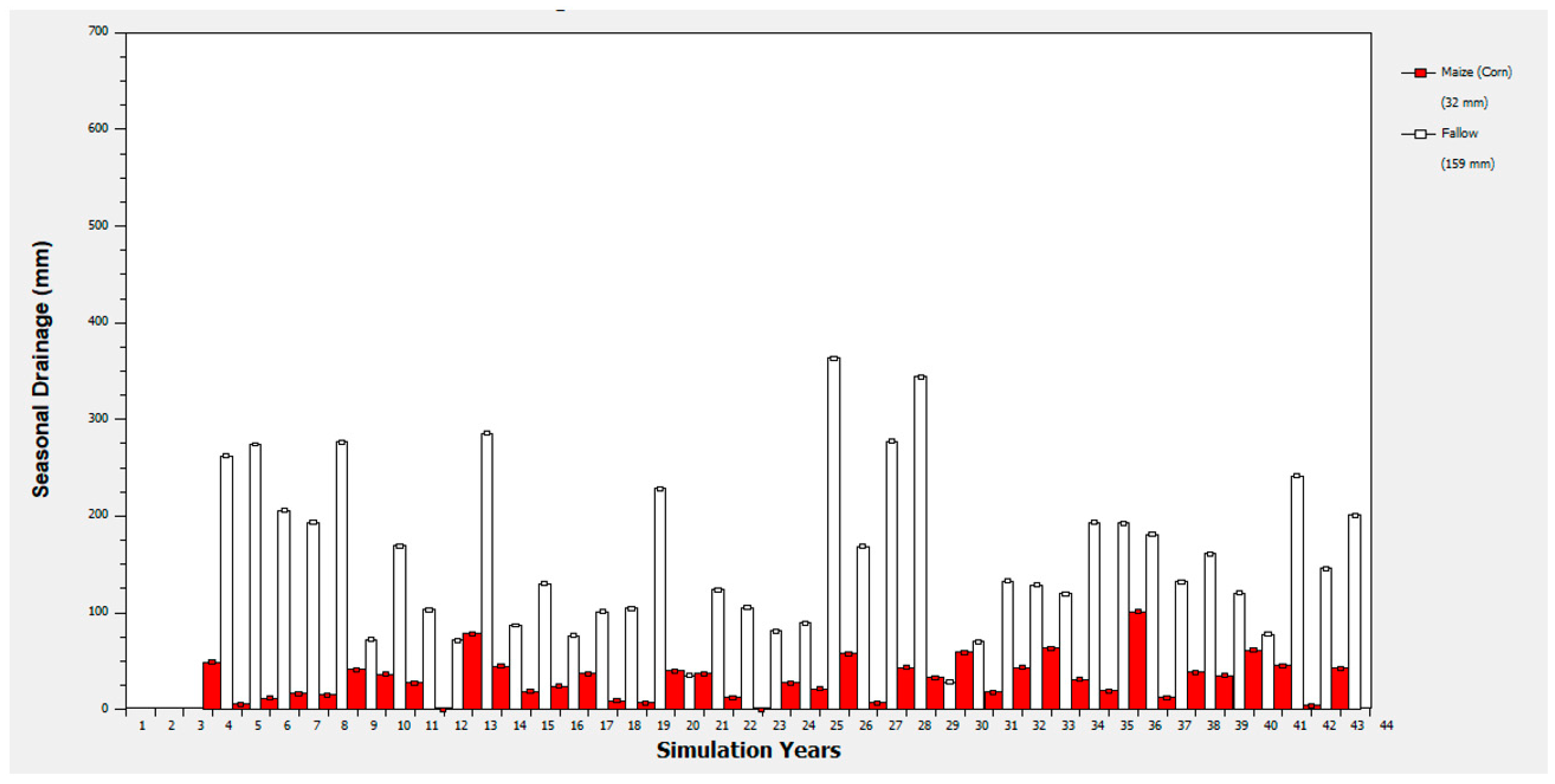
| Fitness-for-Use Category | Description |
|---|---|
| Ideal | A water quality that would not normally impair the fitness of the water for its intended use |
| Acceptable | A water quality that would exhibit some impairment to the fitness of the water for its intended use |
| Tolerable | A water quality that would exhibit increasingly unacceptable impairment to the fitness of the water for its intended use |
| Unacceptable | A water quality that would exhibit unacceptable impairment to the fitness of the water for its intended use |
| Ideal | Acceptable | Tolerable | Unacceptable | ||
|---|---|---|---|---|---|
| Suitability Indicator | Measure of Suitability Indicator | Criteria for Indicators of Soil Quality | |||
| Soil profile salinity | EC of saturation extract (mSm) | 0–200 | 200–400 | 400–800 | >800 |
| Soil permeability | Degree of reduced permeability | None | Slight | Moderate | Severe |
| Oxidisable carbon loading | COD load (kg/ha per month) | 0–400 | 400–1000 | 1000–1600 | >1600 |
| Trace element accumulation | Number of years to reach soil accumulation threshold | >200 years | 150–200 years | 100–150 years | <100 years |
| Criteria for Indicators of Crop Yield and Quality | |||||
| Root zone effects | Relative crop yield as affected by EC, B, Cl, and Na | 90–100% | 80–90% | 70–80% | <70% |
| Leaf scorching when wetted | Degree of leaf scorching caused by Cl and Na | None | Slight | Moderate | Severe |
| Nutrient supply | Contribution to estimated NPK removal by crop | 0–10% | 10–30% | 30–50% | >50% |
| Microbial contamination | Excess infections per 1000 persons p.a. | <1 | 1–3 | 3–10 | >10 |
| Qualitative atrazine damage | Atrazine load (g/ha) | Differentiated levels depending on crop sensitivity and soil texture | |||
| Criteria for Indicators of Irrigation Equipment | |||||
| Corrosion | Langelier Index | 0 to −0.5 | −0.5 to −1.0 | −1.0 to −2.0 | <−2.0 |
| Scaling | Langelier Index | 0 to +0.5 | +0.5 to +1.0 | +1.0 to +2.0 | >+2.0 |
| Clogging of drippers | Suspended solids (mg/L) | <50 | 50–75 | 75–100 | >100 |
| Manganese (mg/L) | <0.1 | 0.1–0.5 | 0.5–1.5 | >1.5 | |
| Total iron (mgL) | <0.2 | 0.2–0.5 | 0.5–1.5 | >1.5 | |
| pH | <7.0 | 7.0–7.5 | 7.5–8.0 | >8.0 | |
| E. coli (106 per 100 mL) | <1.0 | 1.0–2.0 | 2.0–5.0 | >5.0 | |
| Irrigation Water EC mS/m | FAO Guidelines [2] | IrrigWQ | ||||||
|---|---|---|---|---|---|---|---|---|
| LF Range | Yield % | LF | Yield % 1 | LF | Yield % 2 | |||
| Range | Mean | Range | Mean | |||||
| Barley | ||||||||
| 530 | 15–20 | 100 | 15.4 | 94–97 | 95.8 | 19.2 | 100 | 100 |
| 670 | 15–20 | 90 | 15.4 | 83–87 | 85.4 | 19.2 | 90–93 | 91.7 |
| 870 | 15–20 | 75 | 15.4 | 68–73 | 70.9 | 19.2 | 77–81 | 79.0 |
| Wheat | ||||||||
| 400 | 15–20 | 100 | 15.2 | 93–96 | 94.4 | 19.1 | 99–100 | 99.9 |
| 490 | 15–20 | 90 | 15.2 | 83–87 | 85.2 | 19.1 | 90–93 | 91.8 |
| 630 | 15–20 | 75 | 15.2 | 68–73 | 70.6 | 19.1 | 77–81 | 78.9 |
| Soybean | ||||||||
| 330 | 15–20 | 100 | 15.6 | 82–90 | 86.2 | 19.5 | 96–100 | 98.9 |
| 370 | 15–20 | 90 | 15.6 | 69–78 | 73.5 | 19.5 | 85–91 | 88.0 |
| 420 | 15–20 | 75 | 15.6 | 54–65 | 58.8 | 19.5 | 71–78 | 74.8 |
| Maize | ||||||||
| 110 | 15–20 | 100 | 15.7 | 95–97 | 96.4 | 19.6 | 98–100 | 99.1 |
| 170 | 15–20 | 90 | 15.7 | 82–85 | 83.7 | 19.6 | 87–89 | 88.2 |
| 250 | 15–20 | 75 | 15.7 | 67–70 | 68.7 | 19.6 | 73–76 | 74.8 |
| Carrots | ||||||||
| 70 | 15–20 | 100 | 15.0 | 93–95 | 94.3 | 19.9 | 97–98 | 97.4 |
| 110 | 15–20 | 90 | 15.0 | 83–86 | 84.3 | 19.9 | 88–90 | 89.0 |
| 190 | 15–20 | 75 | 15.0 | 62–67 | 65.1 | 19.9 | 71–74 | 72.5 |
| Soil Profile Salinity | Fitness for Use | ECe Interval (mS/m) | Predicted Equilibrium Soil Profile Salinity (mS/m) |
| Ideal | 0–200 | 188 | |
| Acceptable | 200–400 | ||
| Tolerable | 400–800 | ||
| Unacceptable | >800 |
| Soil Profile Salinity | Fitness for Use | ECe Interval (mS/m) | % of Time Soil Profile Salinity Is Predicted to Fall within a Particular Fitness-for-Use Category |
| Ideal | 0 – 200 | 60 | |
| Acceptable | 200 – 400 | 40 | |
| Tolerable | 400 – 800 | ||
| Unacceptable | >800 |
| Soil Profile Salinity | Fitness for Use | ECe Interval (mS/m) | EC Range That Will Give Rise to the Corresponding ECe (mS/m) |
| Ideal | 0–200 | <106 | |
| Acceptable | 200–400 | 106–213 | |
| Tolerable | 400–800 | 213–426 | |
| Unacceptable | >800 | >426 |
| Soil Profile Salinity | Fitness for Use | ECe Interval (mS/m) | Irrigation Water EC That Will Give Rise to the Corresponding ECe for 95% of the Time (mS/m) |
| Ideal | 0–200 | <85 | |
| Acceptable | 200–400 | 85–179 | |
| Tolerable | 400–800 | 179–376 | |
| Unacceptable | >800 | >376 |
| Mean Water Balance Components | Weather Station | ||||
|---|---|---|---|---|---|
| Upington | Vaalharts | Bloem-Fontein | Pretoria | Riebeek Wes | |
| Rainfall season | Summer | Summer | Summer | Summer | Winter |
| Annual precipitation (mm) | 163 | 454 | 565 | 700 | 555 |
| Seasonal precipitation (mm) | 134 | 393 | 485 | 633 | 165 |
| Seasonal irrigation (mm) | 827 | 558 | 484 | 340 | 567 |
| Seasonal evaporation (mm) | 347 | 335 | 331 | 301 | 241 |
| Seasonal transpiration | 599 | 539 | 513 | 468 | 478 |
| Seasonal evapotranspiration (mm) | 945 | 874 | 844 | 769 | 719 |
| Seasonal drainage (mm) | 16 | 80 | 129 | 207 | 32 |
| Seasonal leaching fraction (%) | 1.7 | 8.4 | 13.3 | 21.2 | 4.3 |
| Annual leaching fraction (%) | 2.2 | 9.5 | 14.0 | 21.9 | 17.0 |
| Lowest seasonal root zone salinity (mS/m in saturation extract) | 275 | 110 | 72 | 47 | 91 |
| Highest seasonal root zone salinity (mS/m in saturation extract) | 2557 | 540 | 376 | 189 | 249 |
| Relative Yield (%) | % of Time Yield Is Predicted to Fall within a Corresponding Yield Range | ||||
|---|---|---|---|---|---|
| Upington | Vaalharts | Bloemfontein | Pretoria | Riebeek Wes | |
| 90–100 | 0 | 32 | 78 | 100 | 100 |
| 80–90 | 2 | 35 | 18 | 0 | 0 |
| 70–80 | 5 | 22 | 5 | 0 | 0 |
| <70 | 92 | 10 | 0 | 0 | 0 |
Disclaimer/Publisher’s Note: The statements, opinions and data contained in all publications are solely those of the individual author(s) and contributor(s) and not of MDPI and/or the editor(s). MDPI and/or the editor(s) disclaim responsibility for any injury to people or property resulting from any ideas, methods, instructions or products referred to in the content. |
© 2023 by the authors. Licensee MDPI, Basel, Switzerland. This article is an open access article distributed under the terms and conditions of the Creative Commons Attribution (CC BY) license (https://creativecommons.org/licenses/by/4.0/).
Share and Cite
du Plessis, H.M.; Annandale, J.G.; Benadé, N. A Decision Support System That Considers Risk and Site Specificity in the Assessment of Irrigation Water Quality (IrrigWQ). Appl. Sci. 2023, 13, 12625. https://doi.org/10.3390/app132312625
du Plessis HM, Annandale JG, Benadé N. A Decision Support System That Considers Risk and Site Specificity in the Assessment of Irrigation Water Quality (IrrigWQ). Applied Sciences. 2023; 13(23):12625. https://doi.org/10.3390/app132312625
Chicago/Turabian Styledu Plessis, Heinrich M., John G. Annandale, and Nico Benadé. 2023. "A Decision Support System That Considers Risk and Site Specificity in the Assessment of Irrigation Water Quality (IrrigWQ)" Applied Sciences 13, no. 23: 12625. https://doi.org/10.3390/app132312625





